Table of Contents
South America is rich in natural resources and mining and minerals comprise a large part of the region’s economy. Mining in the Amazon rainforest has become more prevalent in the last two decades since mineral deposits in the mountains of the region have been depleted. The Amazon is home to vast mineral deposits and South American leaders, eager to channel their countries along the path of development, have granted mining rights to thousands of hectares of rainforest.
Resources
Mining activities in the Amazon rainforest occur in the South American countries of Peru, Colombia, Bolivia, Ecuador, Venezuela and Brazil. According to the United States Department of State, “Peru is the world’s largest producer of silver, the second-largest in zinc and the third largest in copper and tin.” Mineral exports accounted for 63% of Peru’s export earnings in 2008. Colombia is the fifth largest exporter of coal in the world, and it has also recently opened the Amazon rainforest to mining gold, silver, copper and molybdenum. Brazil exploits large deposits of iron and manganese. The nickel, tin, bauxite, beryllium, copper, lead, tungsten, zinc and gold from Brazil are considered almost depleted.
Benefits
Mining occupies large percentages in the economies of South American countries, generating income for public projects and infrastructure. The mineral resources of South America give the region a favourable position in the global economic scenario and influence on other global trade policies. The mining industry also notes that while it is criticized for damaging the environment, “the original fauna and flora of much of the land involved in mining are restored once mining operations have ceased,” according to the European Association of Aluminum (AEA).
Ambient
Mining in Amazonia causes a vast degradation of the environment. Tropical forests are some of the most biodiverse and most fragile biomes in the world. Deforestation occurs as a result of removing the bark of the rainforest to expose mineral deposits. While mining companies boast about restoring the forest, converting mining sites back to true rainforests is difficult; Much of the original ecosystem has been lost. Soil and water pollution are other environmental consequences of mining.
Culture
Mining in the Amazon rainforest affects people who depend on the resources of the forest for their livelihood. According to the World Tropical Rainforest Movement, “mining projects in the Amazon endanger the very survival of local communities because mining operations pollute rivers, decrease native flora and fauna, and restrict the use of resources natural by the ancestral inhabitants of the region. ” Water and soil pollution makes it impossible for communities to cultivate, putting the subsistence lifestyle of Amazonian communities in serious danger.
Regulation
Although South American governments have traditionally granted generous concessions to foreign mining companies, and have even repealed laws that prohibit mining practices in national protected wildlife areas, there are some protective regulations. The Inter-American Commission on Human Rights helps protect the rights of indigenous communities threatened by mining and other destructive practices. Convention 169 adopted by the International Labor Organization “establishes a system of protection and consulting mechanisms above the laws, projects and policies that affect the native lands of native peoples,” according to the News Agency EntrePrensa Service.
